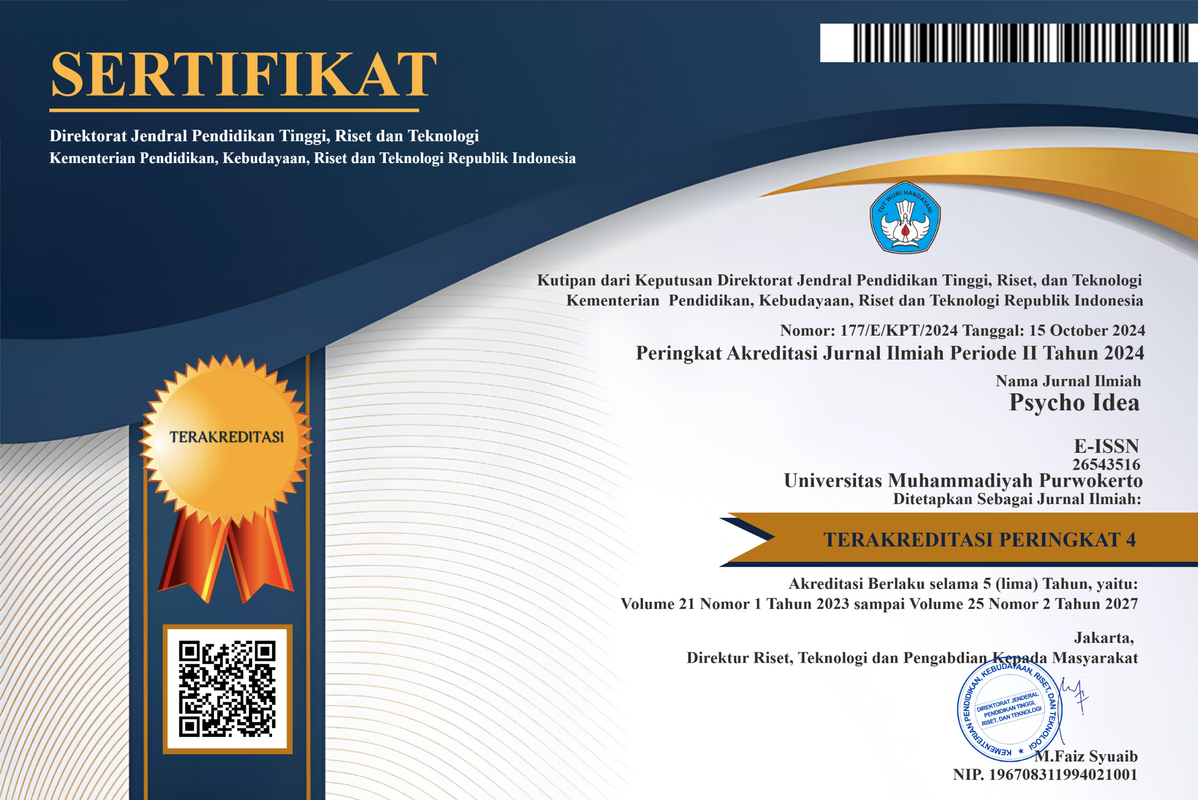Cyberloafing: Peranan Conscientiousness terhadap Pemalasan Siber pada Karyawan
DOI:
https://doi.org/10.30595/psychoidea.v17i2.4195Keywords:
Conscientiousness, Cyberloafing, pemalasan siberAbstract
Penelitian ini bertujuan untuk mengetahui hubungan antara conscientiousness dan cyberloafing. Hipotesis yang diajukan dalam penelitian ini adalah ada hubungan negatif antara conscientiousness dengan cyberloafing. Subjek penelitian dalam penelitian ini adalah karyawan yang bekerja di PT. C sebanyak 105 orang yang dipilih dengan metode purposive sampling. Data diperoleh dari Skala untuk mengukur conscientiousness dan cyberloafing. Perhitungan dilakukan dengan melalui uji prasyarat analisis (uji asumsi) yang terdiri dari uji normalitas dan uji linearitas hubungan. Analisis data yang digunakan adalah menggunakan korelasi Product Moment melalui bantuan SPSS 17 for Windows. Hasil analisis data menunjukan koefisien korelasi sebesar -0.561 dengan p sebesar 0,000 (p < 0,05) yang menunjukkan adanya hubungan negatif antara conscientiousness dengan cyberloafing. Hasil penelitian ini menunjukkan bahwa sumbangan yang diberikan variabel conscientiousness terhadap cyberloafing adalah sebesar 31,5%.
References
Anandarajan, M. & Simmers, C. A. (2004). Personal Web Usage in the Workplace: A Guide to Effective Human Resources Management. USA: Idea Group Inc.
Asosiasi Penyelenggara Jasa Internet Indonesia. (2016). Penetrasi dan Perilaku Pengguna Internet di Indonesia. Dinduh dari: https://apjii.or.id/content/read/39/264/Survei-Internet-APJII-2016 tanggal 30 Desember 2017
Azwar, S. (2013). Penyusunan Skala Psikologi. Yogyakarta: Pustaka Pelajar.
Blau, G., Yang, Y. & Phd, Ward-Cook, K. (2006). Testing a measure of cyberloafing.Journal of Allied Health, 35(1), 9-17.
Feist, J. & Feist, G. J. (2008). Theories of Personality (ed 7th). USA: The McGraw-Hill Companies, Inc.
Fuadiah, L., Anward, H. H. & Eriyani, L. (2016). Peranan conscientiousness terhadap perilaku cyberloafing pada mahasiswa. Jurnal Ecopsy, 3(1).http://dx.doi.org/10.20527/ecopsy.v3i1.1942
Jia, H., Jia, R. & Karau, S. (2013). Cyberloafing and Personality: The Impact of the Big Five Traits and Workplace Situational Factors. Journal of Leadership & Organizational Studies, XX(X), 1-8.https://doi.org/10.1177/1548051813488208
Jiang, H. (2016). Employee Personal Internet Usage in the Workplace. Jyväskylä: Jyväskylä University Printing House.
O’Neill, T. A., Hambley, L. A., &Bercovich, A.(2014). Prediction of cyberslacking when employees are working away from the office. Computers in Human Behaviour, 34, 291-298. https://doi.org/10.1016/j.chb.2014.02.015
Pervin, L. A., Cervone, D., & John, O. P. (2015). Psikologi Kepribadian Teori & Penelitian Edisi Kesembilan. Jakarta: Kencana Prenamedia Group.
Priyatno, D. (2011). Buku Saku Analisis Statistik Data SPSS. Yogyakarta: Gaya Media.
Raad, B. D. (2000). The Big Five Personality Factors The Psycholexical Approach to Personality (Ed 9th). Germany: Hongrefe & Huber Publishers.
Ryckman, R. M. (2008). Theories of Personality. USA: Thomson Wadsworth.
Sugiyono. (2007). Statistika Untuk Penelitian. Bandung: CV Alfabeta.
Varghese, L. & Barber, L. K. (2017). A preliminary study exploring moderating effects of role stressors on the relationship between Big Five personality traits and workplace cyberloafing. Cyberpsychology: Journal of Pychosocial Research on Cyberspace, 11 (4), article 4. http://dx.doi.org/10.5817/CP2017-4-4
Downloads
Published
Issue
Section
License
Authors published in this journal agree to the following terms:
- The copyright of each article is retained by the author (s) without restrictions
- The journal allows the author(s) to retain publishing rights without restrictions
- The author grants the journal the first publication rights with the work simultaneously licensed under the Creative Commons Attribution License, allowing others to share the work with an acknowledgment of authorship and the initial publication in this journal.
- Authors may enter into separate additional contractual agreements for the non-exclusive distribution of published journal versions of the work (for example, posting them to institutional repositories or publishing them in a book), with acknowledgment of their initial publication in this journal
- Authors are permitted and encouraged to post their work online (For example in the Institutional Repository or on their website) before and during the submission process, as this can lead to productive exchanges, as well as earlier and larger citations of published work
- Articles and all related material published are distributed under a Creative Commons Attribution-4.0 International Public License (CC - BY 4.0).
License
Psycho Idea is licensed under a Creative Commons Attribution- 4.0 International Public License (CC - BY 4.0).
You are free to :
Share — copy and redistribute the material in any medium or format
Adapt — remix, transform, and build upon the material for any purpose, even commercially











